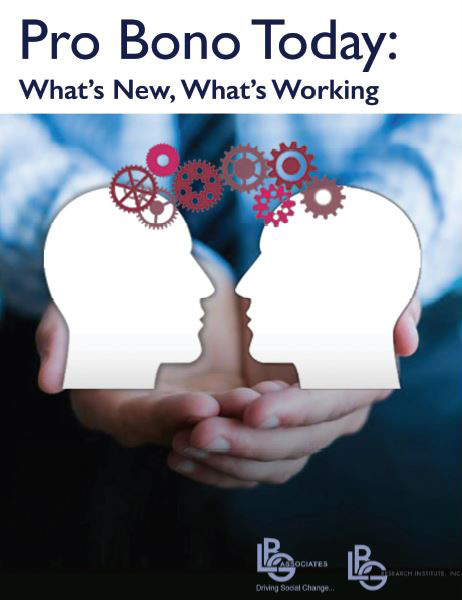
Not too long ago, LBG Associates and LBG Research Institute studied the challenges of pro bono from the nonprofit point of view. Since then, we’ve been wondering what companies have been doing with their pro bono programs that might help nonprofits overcome some of the challenges identified in that study. We also wondered what innovative or unique practices companies have come up with.
So we went to the source. We selected 12 companies with reputations for having solid pro bono programs. We interviewed both the company and one of its nonprofit partners. After the interviews, we had to admit that we hadn’t uncovered anything particularly innovative. But we did find a lot to be excited about. The result is the newly published report, “Pro Bono Today: What’s New, What’s Working.”
The companies in the study are continually evaluating their programs to increase their reach and effectiveness. Some of these changes are addressing reasons why nonprofits have been reluctant to engage pro bono volunteers, And collectively, these efforts are moving the practice of pro bono forward:
Expanding Opportunity for Both Employee and Nonprofits:
The philosophy of “pro bono for all” is spreading. Companies are adding different levels of service, from high to low commitment, so more employees and nonprofits can benefit from pro bono. The lower commitment opportunities, like a half-day or full-day engagement, help nonprofits dip their toes into pro bono without a big commitment, something they asked for in our earlier study. So does having a menu of pre-scoped projects from which to choose.
Setting Development Goals for Employee Volunteers:
Companies are reaping the benefits of pro bono as a leadership development tool, setting and evaluating development goals for participating employees. While companies have known for a while that pro bono can be a good professional development tool, they haven’t embraced it to the degree that we observed in our study before. In some cases, the talent development team is responsible for identifying potential volunteers and working with their managers to select the right ones for the job. In general, high-potential employees are tapped for projects that require the most time and commitment, such as loaned employee programs.
Measuring More Outcomes and Impacts:
Besides tracking employee skill development, companies are conducting more comprehensive studies of nonprofit impact. For example, employees are surveyed post-project about their experience from start to finish. Additionally, they are asked to assess their personal skill development and how they plan to apply their new or enhanced skills to their regular jobs. On the nonprofit side, they are also asked to evaluate the experience; and about impact on the organization. Many companies in the study continue to survey their partners at regular intervals post-project to check up on implementation and impact—as far out as three years in one company’s case.
Using Third Parties to Help with Nonprofit Preparation:
Pro bono program management is time-consuming. Hiring third parties with expertise in helping nonprofits get ready for a pro bono engagement allows companies to focus on preparing their employees. Having this help is a huge bonus for the nonprofits and addresses some of the biggest challenges—knowing what to expect, how to work with volunteers, and how to properly scope a project for success. It also helps the nonprofit to have a third-party to communicate their concerns to instead of their corporate partner.
The report contains a lot more insights into how pro bono is conducted today. You can download it for free on our website at www.lbg-associates.com.
About LBG Associates
LBG Associates is a woman-owned consulting firm focused on designing, implementing and managing corporate citizenship and employee engagement programs and initiatives. Founded in 1993 by Dr. Linda Gornitsky, LBG Associates drives social change through advice, implementation, research and training. Find more information at: www.lbg-associates.com.

